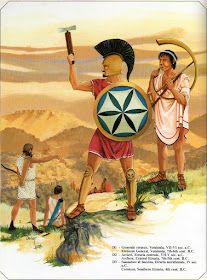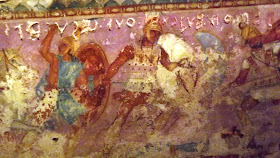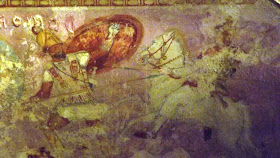 |
| Battle between Greeks and Amazons - Sarcophagus from Tarquinia, 430 - 340 BC, Florence, National Archaeological Museum |
This week Carolyn and I spent time in Tuscany, specifically Pisa and Florence to celebrate one of Carolyn's significant birthdays.
Given this was Carolyn's trip, the agenda for our site seeing time was very much hers. That said this part of Italy is well endowed with multiple sites of interest to a wargamer and so I have pulled together some highlights that I thought the followers of this blog would find interesting.
Pisa is the main stop off point for air travellers from the UK and so we spent a day there before catching the train to Florence. Most normal people are attracted to the buildings seen below and many less normal seem to delight in posing for photos suggesting they are holding up the leaning tower - ho hum!! I however was immediately drawn to the site that originally drew sight seers to the city before a certain tower grabbed the lime light, namely the Camposanto (Holy Field) of Pisa
 |
| Carolyn enjoying her birthday in Pisa |
Since the war the authorities have painstakingly reconstructed the surviving artworks, ancient monuments and sarcophagi presenting the modern visitor with an amazing collection of artefacts and art that cover the centuries. Needless to say the military and particularly Roman history caught my eye.
In a land littered with great art from antiquity it is little wonder that items were often recycled through the centuries and thus many nobles from the renaissance period found their mortal remains interred in a Roman sarcophagus or these great marble boxes could end up as rather impressive water troughs. This early example of green recycling has ensured that many of these impressive items are still around today, some in incredibly good condition.
 |
| With the dogs and wild boar in the foreground, a common animal in the Tuscan countryside, one might assume this individual liked his hunting |
Tuscany is the former ancient Etruria and the Etruscans were a separate tribe in competition with their developing neighbour to the south, Rome. I hadn't realised the significance of the wolf and suckling babes being an Etruscan symbol, long before it was the adopted symbol and part of the mythological story behind Rome and its early history. The wolf and twins is a common site in this part of Italy.
https://en.wikipedia.org/wiki/Etruria
 |
| The Etruscan wolf and twins |
 |
| Giotto's bell tower seen from the top of the dome of Florence Cathedral in the Piazza del Duomo, Florence |
One attraction I was keen to visit whilst in Florence was the National Archaeological Museum. This museum holds some interesting collections focusing on the Etruscan, Egyptian and Roman civilisations and it was the particularly the former that I was keen to see.
 |
| Etruscan Spear head and butt together with a knife blade |
 |
| In situ grave site with grave goods - Bronze spear head |
 |
| Bronze spear butt, top left and shield boss |
http://jjwargames.blogspot.co.uk/2014/07/oxford-ashmolean-museum.html
 |
| Warrior with Corinthian helmet and a pair of bronze greaves. The shield reconstruction shows embossed animals and birds |
http://spazioinwind.libero.it/popoli_antichi/Etruschi/Populonia-cerbone.html
http://www.canino.info/inserti/monografie/etruschi/etruschi_toscana/populonia/
https://en.wikipedia.org/wiki/Vetulonia
 |
| Warrior with helmet, graves and shield fragments |
The story has it that the early Etruscans
were Greeks from the island of Lemos, although recent DNA testing seems to
suggest a strong component of local Latin types as well. The hoplite appearance
of these warriors would certainly indicate that Greek influence.
As a wargamer, how could I ignore these examples of early "bones", and as a self confessed promoter of the virtues of computer moderated rules, I still love to roll dice now and then. The drama they provide to any game is as popular now as it was in the 7th century BC
A classic illustration of the Etruscan warrior with an impressive panoply on his helmet and the intricate pattern on the shield as illustrated in the previous reconstructions
The collection of funeral urns below still showed the traces of the original paint that would have brought these battle scenes to vivid life.
The Egyptian collection of Pharonic items had some very eye-catching artefacts including the hunting chariot below.
Axes, a dagger and spear throwers - New Kingdom 1550-1069 BC
Coins of Alexander the Great, Ptolemy I and his wife Berenice, Arsinoe II wife of Ptolemy II, Ptolemy VI and Mark Anthony and Cleopatra VII
Next up was perhaps for me the most impressive item, the Sarcophagus from Tarquinia, 400-300 BC with these wonderful illustrations of Greek warriors fighting Amazons. The room is kept very dark, presumably for the preservation of the colours, but I think the camera caught the detail and colour in these pictures.
Tiberius, step-son to Augustus was, it seems to me, a complicated character and it is difficult to form a precise judgement about his reign in the light of the death of the wonder boy Germanicus and the rule of terror under Sejanus, not to mention his supposed extra curricular activities he indulged in in his early retirement from public life to his villa on Capri.
My eternal image of Tiberius is of the late George Baker's portrayal in the BBC series "I Claudius"
in which he portrayed the young Tiberius' struggle for recognition from his step-father and his gradual decline into subversion and depravity alongside the duplicitous scheming Sejanus played by Patrick Stewart.
 |
| George Baker as Tiberius and Patrick Stewart as Sejanus in "I Claudius" |
 |
| Bronze bust of Emperor Tiberius 14 - 37 AD |
 |
| Emperor Trebonianus Gallus 251 - 53 AD |
http://www.roman-empire.net/decline/trebonianus.html
Gallus was born into an old Etruscan family and into an Empire on the wane with plague, invasions and internal wars to contend with; his Imperial career came to a short and bloody end, dying at the hands of his own troops.
And finally a Negau style, bronze bucket helmet with a very fancy ornate ornament to its front, found in Livorno.
If you visit Florence I would definitely recommend a visit to the National Museum of Archaeology.






























Great travelogue, Jonathan! When we were in Tuscany in 2014, we missed the National Museum of Archaeology. With so many great museums in Florence, it is difficult to visit them all in one trip. This gives me another reason to visit again. Did you try the wild boar while you were there? There was a place near the river serving excellent boar with pasta. Groms for gelato? A treat!
ReplyDeleteThanks Jonathan, yes I know what you mean about museums. We were only over for five days and I know we could have seen much much more than we did, even though we packed a lot of stuff in.
DeleteWe were recommended to try the wild boar with pasta and yes it was excellent. We also tried some of the salami at a Chianti wine tasting which was also very good.
Tuscany is beautiful and I can see why it appears in so many films, I kept seeing in my mind the James Bond scenes in Sienna during the horse race in the town and the villa scenes from Gladiator.
Very interesting stuff JJ, and well worth the read.
ReplyDeleteI found the Egyptian hunting chariot and the colours on the sarcophagus very interesting indeed, alongside a young Patrick Stewart with hair - although, presumably, not his own even then. I have been meaning to revisit "I Claudius" but have been a little reluctant to do so as I am worried whether it has stood the test of time (and feel the same about the excellent "War and Peace" which was Anthony Hopkins's breakthrough role, of course) and don't want to run the risk of destroying a great memory. Given that it had so many great British actors though, I'm probably worrying about nothing.
Either way it looks like you both had a great time and, as Jonathan notes above, it always seems to come back to the food. Next to the French, I think the Italians have that one well and truly covered!
Thanks Lawrence, glad you enjoyed it. That sarcophagus makes an excellent painting reference for any Greek painting jobs, particularly the decorations on the linen armour of the hopolite warriors.
DeleteI know what you mean about looking back at old TV shows. I have the BBC video of the original "War & Peace" and although still displaying great performances by the cast does show its age with the production qualities. I think you have to see it with that caveat in mind, although the cast in "I Claudius" had just about all the greats in British acting appearing and certainly benefits from that talent even now.
Yes indeed, the older I get the more I appreciate the great national cuisines and as you say, French and Italian are right up there.